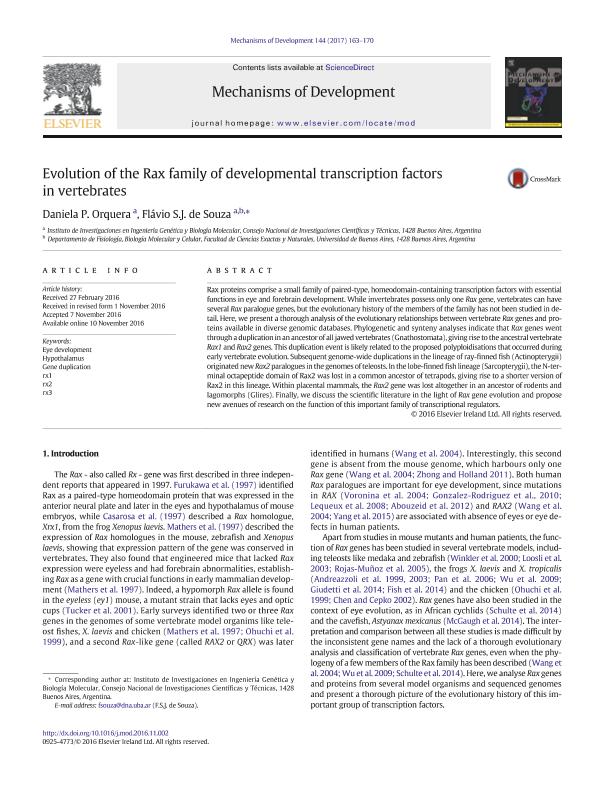Artículo
Evolution of the Rax family of developmental transcription factors in vertebrates
Fecha de publicación:
04/2017
Editorial:
Elsevier Science
Revista:
Mechanisms of Development
ISSN:
0925-4773
Idioma:
Inglés
Tipo de recurso:
Artículo publicado
Clasificación temática:
Resumen
Rax proteins comprise a small family of paired-type, homeodomain-containing transcription factors with essential functions in eye and forebrain development. While invertebrates possess only one Rax gene, vertebrates can have several Rax paralogue genes, but the evolutionary history of the members of the family has not been studied in detail. Here, we present a thorough analysis of the evolutionary relationships between vertebrate Rax genes and proteins available in diverse genomic databases. Phylogenetic and synteny analyses indicate that Rax genes went through a duplication in an ancestor of all jawed vertebrates (Gnathostomata), giving rise to the ancestral vertebrate Rax1 and Rax2 genes. This duplication event is likely related to the proposed polyploidisations that occurred during early vertebrate evolution. Subsequent genome-wide duplications in the lineage of ray-finned fish (Actinopterygii) originated new Rax2 paralogues in the genomes of teleosts. In the lobe-finned fish lineage (Sarcopterygii), the N-terminal octapeptide domain of Rax2 was lost in a common ancestor of tetrapods, giving rise to a shorter version of Rax2 in this lineage. Within placental mammals, the Rax2 gene was lost altogether in an ancestor of rodents and lagomorphs (Glires). Finally, we discuss the scientific literature in the light of Rax gene evolution and propose new avenues of research on the function of this important family of transcriptional regulators.
Palabras clave:
Eye Development
,
Hypothalamus
,
Gene Duplication
,
Rx1 Rx2 Rx3
Archivos asociados
Licencia
Identificadores
Colecciones
Articulos(INGEBI)
Articulos de INST.DE INVEST.EN ING.GENETICA Y BIOL.MOLECULAR "DR. HECTOR N TORRES"
Articulos de INST.DE INVEST.EN ING.GENETICA Y BIOL.MOLECULAR "DR. HECTOR N TORRES"
Citación
Orquera, Daniela Paula; Silva Junqueira de Souza, Flavio; Evolution of the Rax family of developmental transcription factors in vertebrates; Elsevier Science; Mechanisms of Development; 144; Part B; 4-2017; 163-170
Compartir
Altmétricas




